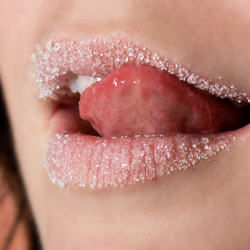|
|
Secrets of Female Sexual Arousal: A Complete Study
 Various
research studies has been done on female sexual arousal but this an area that
still needs to be fully understood. Women Fitness brings to you a complete
resource on these studies and researches about female sexual arousal. Various
research studies has been done on female sexual arousal but this an area that
still needs to be fully understood. Women Fitness brings to you a complete
resource on these studies and researches about female sexual arousal.
Sexual arousal or sexual excitement is the arousal of sexual desire, during or
in anticipation of sexual activity. A number of physiological responses occur in
the body and mind as preparation for sex and continue during it. Genital
responses are not the only changes, but noticeable and necessary for consensual
and comfortable intercourse. Male arousal will lead to an erection and in female
arousal, the body's response is engorged sexual tissues such as nipples, vulva,
clitoris, vaginal walls and vaginal lubrication. Mental stimuli and physical
stimuli such as touch, and the internal fluctuation of hormones, can influence
sexual arousal.
Sexual arousal has several stages and may not lead to any actual sexual
activity, beyond a mental arousal and the physiological changes that accompany
it. Given sufficient sexual stimulation, sexual arousal in humans reaches its
climax during an orgasm. It may also be pursued for its own sake, even in the
absence of an orgasm.
There are several informalities, terms and phrases to describe sexual arousal
including horny, turned on, randy, steamy, and lustful. Things that precipitate
human sexual arousal are called erotic stimuli, colloquially known as turn-ons.
Depending on the situation, a person can be sexually aroused by a variety of
factors, both physical and mental. A person may be sexually aroused by another
person or by particular aspects of that person, or by a non-human object. The
welcome physical stimulation of an erogenous zone or acts of foreplay can result
in arousal, especially if it is accompanied with the anticipation of imminent
sexual activity. Sexual arousal may be assisted by a romantic setting, music or
other soothing situation. The potential stimuli for sexual arousal vary from
person to person, and from one time to another, as does the level of arousal.
Stimuli can be classified according to the sense involved: somatosensory
(touch), visual, and olfactory (scent). Auditory stimuli are also possible,
though they are generally considered secondary in role to the other three.
Erotic stimuli which can result in sexual arousal can include conversation,
reading, films or images or a smell or setting, any of which can generate erotic
thoughts and memories in a person. Given the right context, these may lead to
the person desiring physical contact, including kissing, cuddling, and petting
of an erogenous zone. This may in turn make the person desire direct sexual
stimulation of the breasts, nipples, buttocks and/or genitals, and further
sexual activity.
Erotic stimuli may originate from a source unrelated to the object of subsequent
sexual interest. For example, many people may find nudity, erotica or
pornography sexually arousing, which may generate a general sexual interest
which is satisfied with sexual activity. When sexual arousal is achieved by or
dependent on the use of objects, it is referred to as sexual fetishism, or in
some instances a paraphilia.
There is a common belief that women need more time to achieve arousal. However,
recent scientific research has shown that there is no considerable difference
for the time men and women require to become fully aroused. Scientists from
McGill University Health Centre in Montreal, Canada used the method of thermal
imaging to record baseline temperature change in genital area to define the time
necessary for sexual arousal. Researchers studied the time required for an
individual to reach the peak of sexual arousal while watching sexually explicit
movies or pictures and came to the conclusion that on average women and men took
almost the same time for sexual arousal � around 10 minutes.
The time needed for foreplay is very individualistic and varies from one time to
the next depending on many circumstances.
Unlike many other animals, humans do not have a mating season, and both sexes
are potentially capable of sexual arousal throughout the year.
 Sexual arousal causes various physical responses, most significantly in the sex
organs (genital organs). Sexual arousal for a man is usually indicated by the
swelling and erection of the penis when blood fills the corpus cavernosum. This
is usually the most prominent and reliable sign of sexual arousal in males. In a
woman, sexual arousal leads to increased blood flow to the clitoris and vulva,
as well as vaginal transudation - the seeping of moisture through the vaginal
walls which serves as lubrication. Sexual arousal causes various physical responses, most significantly in the sex
organs (genital organs). Sexual arousal for a man is usually indicated by the
swelling and erection of the penis when blood fills the corpus cavernosum. This
is usually the most prominent and reliable sign of sexual arousal in males. In a
woman, sexual arousal leads to increased blood flow to the clitoris and vulva,
as well as vaginal transudation - the seeping of moisture through the vaginal
walls which serves as lubrication.
Female Sexual Arousal
When the female is sexually aroused, the vulva is wet and the labia are slightly
engorged. It may be accompanied by
-
Erection of nipples
-
Vaginal lubrication
-
Vasocongestion of the vaginal walls
-
Tumescence and erection of the clitoris and labia
-
Elevation of the cervix and uterus
-
Tenting, i.e. expansion of the inner 2/3 of the vagina
-
Change in shape, color and size of the labia majora and labia minora
-
Pupil dilation
the beginnings of sexual arousal in a woman's body is usually marked by vaginal
lubrication (wetness), swelling and engorgement of the external genitals, and
internal enlargement of the vagina. There have been studies to find the degree
of correlation between these physiological responses and the woman's subjective
sensation of being sexually aroused: the findings usually are that in some cases
there is a high correlation, while in others, it is surprisingly low.
Further stimulation can lead to further vaginal wetness and further engorgement
and swelling of the clitoris and the labia, along with increased redness or
darkening of the skin in these areas. Further changes to the internal organs
also occur including to the internal shape of the vagina and to the position of
the uterus within the pelvis. Other changes include an increase in heart rate as
well as in blood pressure, feeling hot and flushed and perhaps experiencing
tremors. A sex flush may extend over the chest and upper body.
If sexual stimulation continues, then sexual arousal may peak into orgasm. After
orgasm, some women do not want any further stimulation and the sexual arousal
quickly dissipates. Suggestions have been published for continuing the sexual
excitement and moving from one orgasm into further stimulation and maintaining
or regaining a state of sexual arousal that can lead to second and subsequent
orgasms. Some women have experienced such multiple orgasms quite spontaneously.
While young women may become sexually aroused quite easily, and reach orgasm
relatively quickly with the right stimulation in the right circumstances, there
are physiological and psychological changes to women's sexual arousal and
responses as they age. Older women produce less vaginal lubrication and studies
have investigated changes to degrees of satisfaction, frequency of sexual
activity, to desire, sexual thoughts and fantasies, sexual arousal, beliefs
about and attitudes to sex, pain, and the ability to reach orgasm in women in
their 40s and after menopause.
 Other factors have also been studied including socio-demographic variables,
health, psychological variables, partner variables such as their partner's
health or sexual problems, and lifestyle variables. It appears that these other
factors often have a greater impact on women's sexual functioning than their
menopausal status. It is therefore seen as important always to understand the
"context of women's lives" when studying their sexuality. Other factors have also been studied including socio-demographic variables,
health, psychological variables, partner variables such as their partner's
health or sexual problems, and lifestyle variables. It appears that these other
factors often have a greater impact on women's sexual functioning than their
menopausal status. It is therefore seen as important always to understand the
"context of women's lives" when studying their sexuality.
Reduced estrogen levels may be associated with increased vaginal dryness and
less clitoral erection when aroused, but are not directly related to other
aspects of sexual interest or arousal. In older women, decreased pelvic muscle
tone may mean that it takes longer for arousal to lead to orgasm, may diminish
the intensity of orgasms, and then cause more rapid resolution. The uterus
typically contracts during orgasm and, with advancing age, those contractions
may actually become painful.
Psychological sexual arousal involves appraisal and evaluation of a stimulus,
categorization of a stimulus as sexual, and an affective response. The
combination of cognitive and physiological states elicits psychological sexual
arousal. Some suggest that psychological sexual arousal results from an
interaction of cognitive and experiential factors, such as affective state,
previous experience, and current social context.
Next
Dated 09 June 2015
|
|
|
|
|









